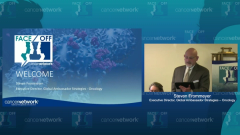
Pediatric-Inspired Chemotherapy Incorporating Pegaspargase in Adults with Ph-ALL
Varun Narendra, MD, describes a clinical trial that studied whether pediatric-inspired ALL regimens could be used in older adults with Philadelphia chromosome–positive ALL.
Episodes in this series

Varun Narendra, MD: The next study I’m going to go over is by our very own Mark Geyer, [MD,] and Jae Park, [MD,] which asks whether pediatric-inspired regimens can be extended to patients who are even older than age 40, ages 40 to 59. The motivation for this study is in part related to prior studies that looked at using pediatric or pegaspargase-containing regimens in patients in that age group of even up to 50 or 60 years old. Other studies have shown high rates of treatment-related mortality. This was a French study that showed treatment-related mortality in the roughly 20% range cumulatively with a French pediatric-inspired regimen. The question is, could one adjust or optimally dose a pediatric-inspired regimen to limit the toxicities associated with that approach while still achieving or gaining the benefit in terms of outcomes?
This was a phase 2, multicenter, prospective study of 39 patients with newly diagnosed B- or T-cell ALL [acute lymphoblastic leukemia]. In this case, patients were ages 18 to 60, including 18 patients [older than] 40 years old, as opposed to the CALGB 10403 study. In this case, the primary objective was MRD [minimal residual disease] negativity following induction phase 1.
To give you a sense of the regimen itself, there are certain differences between this and CALGB 10403. It’s a pediatric-inspired regimen. Importantly, 6 doses of pegaspargase are given throughout the entire course compared with 7 of a slightly lower dose for CALGB 10403. That’s 2000 units/m2 as opposed to 2500 units/m2. There are 3 essential large courses: remission induction, remission consolidation, and maintenance. Some important notes: Induction here is a 2-phase induction. There’s induction 1 and induction 2, with induction 2 mirroring the consolidated phase of CALGB 10403. With respect to maintenance and delayed intensification, that’s essentially given over 2 cycles. Heavier-duty delayed intensification and maintenance here [are] gender agnostic. All patients receive 3-year maintenance, given essentially equivalent rates of relapse [for] men vs women.
With the study, there were notable findings in terms of efficacy. There was a very high rate of CR [complete remission]/CRi [CR with incomplete count recovery]: 97% after induction 2. It was 95% after induction 1, with a 3-year overall survival of 76%. There was a clear signal that older patients responded less favorably, with 40- to 60-year-old patients having an overall survival of 61% compared with 88% in the 18-to-39 age group. Parallel findings are seen with event-free survival.
Overall, these numbers compare relatively similarly or favorably to CALGB 10403, where the event-free survival was in the 60% range. This regimen obtained high rates of MRD negativity: 83% with 10-4 sensitivity, but in this case using flow cytometry. After successive phases of induction therapy, they saw higher rates of MRD negativity, going from 33% after induction phase 1 to 83% after induction phase 2. The study wasn’t powered to determine whether MRD negativity influenced outcomes with this regimen.
Toxicity had been the big concern for this age group. To give you a sense, a median of 3 doses of pegaspargase [was] achieved for these patients, and there were some studies to show that was achieving asparagine depletion in the serum. No patients died during induction 1 or 2 as opposed to the 23% chemotherapy-related mortality that was seen in the French study that I referenced. Two patients died in CR1 [first complete remission], so obviously there’s risk associated with myelosuppressive therapy for years, not surprisingly.
With respect to PEG toxicity, it was largely manageable. There was hypofibrinogenemia in 56% of patients and hypertriglyceridemia in 56%. These were higher than what had been seen in the CALGB 10403 study. One noteworthy toxicity was hyperbilirubinemia, which was seen in 44%, [with] particularly more seen in patients in the 40- to 60-year age group as opposed to 10% in the 18-to-39 age group. However, 9 or 10 of those patients were rechallenged with PEG and were able to tolerate it. This was a smaller study, with just 39 patients, and not randomized. But clearly, it seems to be that optimally defined regimens, pediatric-inspired regimens can be tolerated in patients up to age 60. There are ongoing questions with respect to how one can incorporate novel targeted agents into this regimen as a backbone, but it’s certainly promising.
Transcript edited for clarity.
Newsletter
Stay up to date on recent advances in the multidisciplinary approach to cancer.

















































































